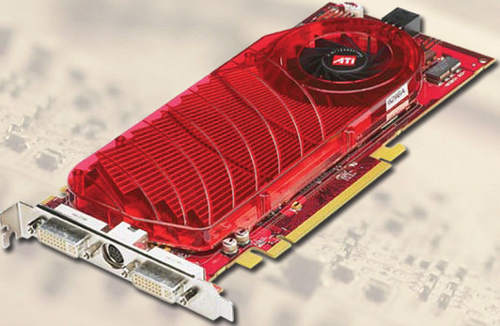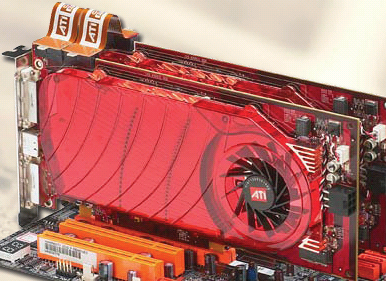ATI Radeon X1950 Pro: CrossFire Done Right
by Derek Wilson on October 17, 2006 6:22 AM EST- Posted in
- GPUs
RV570 and the Demise of the X1900 GT
The silicon used in the X1950 Pro is based on an 8-vertex 36-pixel shader configuration. While the X1900 GT has the same pipeline configuration as the X1950 Pro, the X1900 GT is based on R580 cores with disabled or non-functional pipelines. The RV570 core is built with the X1950 Pro in mind. With the introduction of the X1950 Pro, the X1900 GT will be phased out. It is unclear whether or not ATI has a use planned for R580+ GPUs that don't make the cut on the high end, but it looks like they won't just fall neatly into the X1900 GT. We would like to say that the X1950 Pro has the same core clock speed as the X1900 GT, but the issue is a little more complicated.
The X1900 GT will be going through a slight revision before its disappearance. Due to a shortage of original R580 cores that can clock to 575MHz, ATI is dropping the specs on the X1900 GT to 512MHz while attempting to make up for this by boosting memory speed to 1320MHz from 1200MHz. This is being done to keep the supply of X1900 GT parts steady until the X1950 Pro is able to take over. It is difficult to describe just how inappropriate it is to retard the specs on a long shipping product in this manner.
It is hard enough for us to sort things out when parts hit the shelves at different speeds than originally promised, but to do something like this after a part has been on the market for months is quite astounding. Be very careful when looking at buying an X1900 GT over the next couple months. The safest route is to avoid the X1900 GT altogether and simply let the X1950 Pro act as an immediate replacement for the X1900 GT. Leaving 512MHz product sitting on shelves is the best way to send the message that this type of action is not to be taken again. For our part, we have to express our extreme disappointment in ATI for taking this route. We certainly understand that it is difficult to make decisions about what to do when faced with product shortages, but we would like to strongly urge everyone in the computing industry to avoid doing anything like this to stretch the life of a product.
For now, let's get back to the X1950 Pro. Weighing in at about 330 million transistors and about 230 mm2, the RV570 is no small GPU. In addition to the features listed below, RV570 includes an integrated compositing engine for what ATI calls "native" CrossFire support which we'll explain shortly. The heatsink has a different look to match the rest of the X1950 family in a single slot solution. There are also the new CrossFire connectors in nearly the same position as the NVIDIA SLI bridge position. Here are some pictures and tables to help illustrate.


| NVIDIA Graphics Card Specifications | ||||||||
|
Vert Pipes
|
Pixel Pipes
|
Raster Pipes
|
Core Clock
|
Mem Clock
|
Mem Size (MB)
|
Mem Bus (bits)
|
Price
|
|
| GeForce 7950 GX2 |
8x2
|
24x2
|
16x2
|
500x2
|
600x2
|
512x2
|
256x2
|
$600
|
| GeForce 7900 GTX |
8
|
24
|
16
|
650
|
800
|
512
|
256
|
$450
|
| GeForce 7950 GT |
8
|
24
|
16
|
550
|
700
|
512
|
256
|
$300-$350
|
| GeForce 7900 GT |
8
|
24
|
16
|
450
|
660
|
256
|
256
|
$280
|
| GeForce 7900 GS |
7
|
20
|
16
|
450
|
660
|
256
|
256
|
$200-$250
|
| GeForce 7600 GT |
5
|
12
|
8
|
560
|
700
|
256
|
128
|
$160
|
| GeForce 7600 GS |
5
|
12
|
8
|
400
|
400
|
256
|
128
|
$120
|
| GeForce 7300 GT |
4
|
8
|
2
|
350
|
667
|
128
|
128
|
$100
|
| GeForce 7300 GS |
3
|
4
|
2
|
550
|
400
|
128
|
64
|
$65
|
| ATI Graphics Card Specifications | ||||||||
|
Vert Pipes
|
Pixel Pipes
|
Raster Pipes
|
Core Clock
|
Mem Clock
|
Mem Size (MB)
|
Mem Bus (bits)
|
Price
|
|
| Radeon X1950 XTX |
8
|
48
|
16
|
650
|
1000
|
512
|
256
|
$450
|
| Radeon X1900 XTX |
8
|
48
|
16
|
650
|
775
|
512
|
256
|
$375
|
| Radeon X1900 XT |
8
|
48
|
16
|
625
|
725
|
256/512
|
256
|
$280/$350
|
| Radeon X1950 Pro |
8 |
36 |
12 |
575 |
690 |
256 |
256 |
$200 |
| Radeon X1900 GT |
8
|
36
|
12
|
575
|
600
|
256
|
256
|
$220
|
| Radeon X1650 Pro |
5
|
12
|
4
|
600
|
700
|
256
|
128
|
$99
|
| Radeon X1600 XT |
5
|
12
|
4
|
590
|
690
|
256
|
128
|
$150
|
| Radeon X1600 Pro |
5
|
12
|
4
|
500
|
400
|
256
|
128
|
$100
|
| Radeon X1300 XT |
5
|
12
|
4
|
500
|
400
|
256
|
128
|
$89
|
| Radeon X1300 Pro |
2
|
4
|
4
|
450
|
250
|
256
|
128
|
$79
|










45 Comments
View All Comments
DerekWilson - Tuesday, October 17, 2006 - link
First of all, every site uses their own benchmarking techniques and sequences in the games. Numbers between review sites won't be comparable.For Quake 4 we used ultraquality mode, and this seems to give ATI the advantage over NVIDIA. We don't have a problem with this because we would prefer to tip the scales in favor of the product that can deliver the best performance at the highest image quality.
munky - Tuesday, October 17, 2006 - link
Would you rather Ati continued to ship the x1900gt with the original specs, and then a bunch of the cards would have to be RMA'd?DerekWilson - Tuesday, October 17, 2006 - link
We would rather they just run out of x1900 GT cards. They're discontinuing the line anyways, so it seems a little strange to try to increase supply by underhanded means.sri2000 - Tuesday, October 17, 2006 - link
They should ship it under a different model number. Call is the X1900 GTA or something like that (or some other alphabet soup combo that's not already taken) so that people can tell that the different model# = different performance.Goty - Tuesday, October 17, 2006 - link
You guys are ragging on this CF implementation like it's some sub-par solution. The transfer speed may be lower than that used by NVIDIA's SLI bridge, but SLI is simplex while this implementation is full duplex. Being able to send data in both directions at the same time should provide a huge speed boost while using ATi's SuperAA modes.JarredWalton - Tuesday, October 17, 2006 - link
Scalability is the key factory. In most benchmarks, SLI gets more of an improvement than CrossFire, indicating that the compositing engine is not an optimal multi-GPU solution. There's almost certainly a decent amount of overhead involved. We do like the new CF connector, but the proof is in the pudding. If 7900 GS is clearly slower in single card configs but often faster in dual-GPU configs, clearly SLI is scaling better than CF.mesyn191 - Friday, October 20, 2006 - link
I don't think its possible to comment on the new CF at all, they've clearly got screwed up drivers for it ATM, but then its ATi so what else is new...I hope AMD cleans up thier driver team because still even after all these years ATi does a half assed job on its drivers.
Goty - Tuesday, October 17, 2006 - link
Are you guys thinking of doing any testing with any of either vendor's multi-card AA modes any time soon? I really think the full duplex connection would really help there (i.e. the cards may not scale as well with the number of cards, but what about as the image quality increases?)Rza79 - Tuesday, October 17, 2006 - link
The Tech Report had problems with this motherboard and Crossfire which made them switch to the Asus P5W DH.You aren't expiriencing any problems with this board?
Second thing, why no AA with games like B&W2 and FEAR?
DerekWilson - Tuesday, October 17, 2006 - link
No problems with the motherboard.AA performance under Black and White 2 and FEAR were excluded because we decided framerate was already at a minimum for the resolution we were testing.